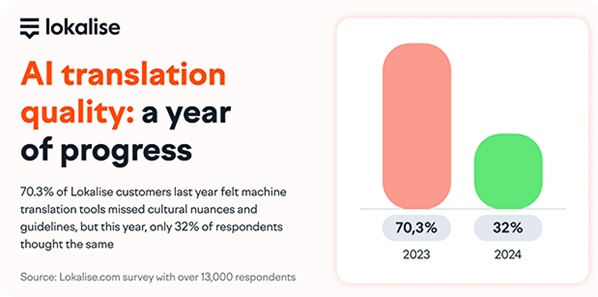
In an effort to evaluate customer satisfaction and perception of AI and machine translation technologies, Lokalise undertook a comparative study of feedback from 2023 and 2024.
Their findings indicate remarkable strides in AI translation accuracy, surpassing expectations and marking a landmark year for innovation in this arena. Let’s explore the details and consider the future of worldwide communication.
AI Trends in 2023: Optimism Meets Skepticism
When generative AI translation tools were launched last year, they were met with cautious optimism. Compared to legacy tools such as Google Translate and DeepL, there were doubts about their capability to deliver accurate translations, especially with uncommon language pairs and culturally rich contexts. A survey of 13,000 Lokalise customers provided insightful perspectives:
– 70.3% felt machine translation often overlooked nuances and cultural context
– Literal translations lacking context and tone led to user dissatisfaction
– Dependence on human translators remained strong, particularly for sensitive content
These insights underscore the complexity of language, a cultural mosaic replete with idioms and subtleties that challenge even native speakers. The concept of machines mastering such intricacies was met with skepticism.
The 2024 Landscape: GenAI Revolutionizes Translation
With the release of Lokalise AI, a tool harnessing generative AI (GenAI) for translation, Lokalise reconnected with their customers to gauge changes in perceptions. This more targeted survey of 800 participants reveals a transformative shift:
– Just 32% now believe machine translations fail to grasp context and guidelines
– This reflects a 38.3% improvement over the course of a single year
Whereas dissatisfaction was prevalent in 2023, by 2024, more than two-thirds of users expressed satisfaction with AI’s capability to interpret nuance and context.

Exploring the Shift in AI Translation Perception
Multiple factors have catalyzed the change in how users perceive machine translation quality:
– Sophisticated language models: Models trained on expansive datasets have refined AI’s understanding of context and subtleties.
– Cultural embedding: Developers are integrating cultural knowledge into AI systems, enhancing comprehension of idiomatic expressions and references.
– Context-aware algorithms: Newly developed algorithms consider overall context, producing translations that are more accurate and natural.
– User-driven improvements: Feedback loops allow AI systems to evolve, learning from user corrections and preferences in real-time.
– Specialized content training: AI tools are increasingly trained on industry-specific content, better equipping them to manage technical jargon.
Envisioning the Future of AI-Powered Translations
Despite significant progress, challenges persist for AI translation:
– Rare languages and pairs: Many AI models continue to struggle with uncommon languages.
– Context-sensitive content: Humor and creative writing still pose difficulties for AI.
– Ethical and privacy concerns: As AI achieves greater linguistic sophistication, issues of privacy and data handling become more pressing.
The road ahead promises further AI translation enhancements, focusing on:
– Deeper context understanding
– More adept handling of idioms
– Enhanced cultural integration
– Real-time translations with greater accuracy




